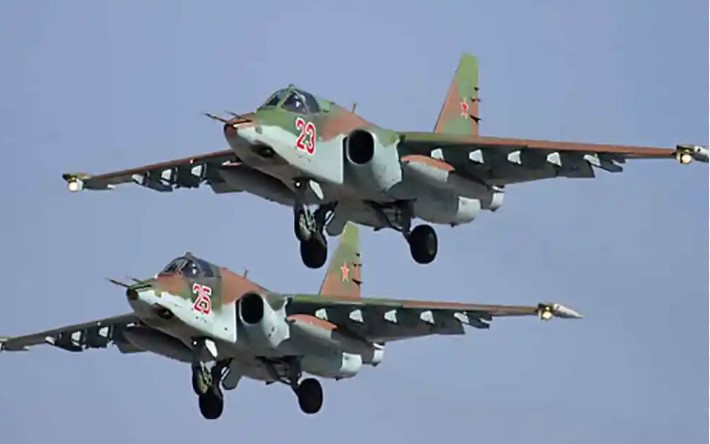A Russian Su-25 fighter jet crashed on March 24 in the Primorye Krai region of Russia, close to the North Korean border. The aircraft was on a routine training mission when the incident occurred.
Su-25 Goes Down During Training Mission
Fortunately, the pilot managed to eject safely and was promptly rescued. The Russian Ministry of Defense has indicated that the crash took place in an uninhabited area, minimizing the risk of collateral damage. Preliminary assessments suggest that a technical malfunction was responsible for the accident. A commission from the Russian Aerospace Forces has been dispatched to investigate the exact cause.
The Su-25, commonly referred to as the “Flying Tank,” is a heavily armored ground attack aircraft that has been in service since the early 1980s. Known for its durability, it is built to withstand heavy fire in combat zones.
However, recent years have seen an increase in crashes involving this aircraft, raising concerns about its operational safety. This latest incident adds to a growing list of Su-25 losses, further questioning the aircraft’s ability to perform in modern combat scenarios.
Also Read: Russia’s MIG-41 Claimed to Outclass F-35
Su-25: A Battle-Tested War Machine
The Su-25 is a single-seat, twin-engine attack aircraft designed for close air support missions. It has a wingspan of 14.36 meters and a fuselage length of 15.33 meters. When fully armed, it can reach speeds of up to 950 km/h and has a combat radius of approximately 375 km.
The aircraft is equipped with a GSh-30-2 30mm cannon and multiple hardpoints capable of carrying bombs, rockets, and air-to-ground missiles. These features make it an effective platform for striking enemy ground targets.
Deadly Algerian Su-30 Crash Raises Doubts on Russian Jets
Designed for battlefield endurance, the Su-25 is heavily armored. The cockpit is surrounded by titanium plating to protect the pilot from bullets and shrapnel. Its engines are mounted separately from the main fuselage, reducing the risk of both being disabled in combat.
Additionally, self-sealing fuel tanks enhance its survivability in hostile environments. This rugged design has earned the Su-25 a reputation as one of the toughest aircraft in military aviation.
Despite these advantages, the Su-25 has suffered significant losses in recent conflicts. Since the start of the Russia-Ukraine war in 2022, more than 30 Su-25s have been destroyed.
Advanced air defense systems, including shoulder-fired missiles and radar-guided weapons, have proven to be a major threat to the aircraft. The Dutch open-source intelligence blog Oryx has reported that 31 Su-25s have been lost, contributing to an overall total of 113 Russian aircraft confirmed as destroyed or damaged during the conflict. The exact number may be higher, but independent verification remains difficult.
Su-25 vs. A-10 Warthog: A Longstanding Rivalry
The Su-25 is often compared to the American A-10 Warthog, its closest Western counterpart. Both aircraft serve as dedicated ground attack platforms, but they have distinct design philosophies.
F-22 Obliterates Russia’s Su-30 and Su-35 in Brutal Aerial Clash in Syrian Skies
The A-10, known for its massive GAU-8 Avenger 30mm cannon, was specifically built for tank-busting missions. It features extensive armor, redundant flight controls, and the ability to loiter over battlefields for extended periods.
In contrast, the Su-25 is designed for rapid deployment and ease of maintenance. While it lacks the A-10’s firepower and loitering capability, it is cheaper to operate and can be repaired quickly in the field. This makes it a valuable asset for prolonged conflicts where sustained air support is necessary. However, as modern warfare evolves, both aircraft face increasing threats from advanced missile systems and drone warfare.
The Su-25 has a long history of combat deployments, including missions in Afghanistan, Chechnya, Georgia, Syria, and Ukraine. In each of these conflicts, it has demonstrated remarkable resilience, often returning to base with significant battle damage. The aircraft’s robust construction and simple design allow it to operate from rough airstrips close to the frontlines, making it an essential component of Russia’s air power.
Su-57 Russia’s Fighter Makes Global Debut at China Air Show
Despite its reputation as a tough and reliable warplane, the Su-25’s recent losses highlight its vulnerability in modern air combat. As anti-aircraft defenses become more sophisticated, the effectiveness of older attack aircraft like the Su-25 continues to be tested in high-intensity battlefields. While it remains a key asset for Russian and Ukrainian forces, its future in warfare remains uncertain as newer technologies emerge.

